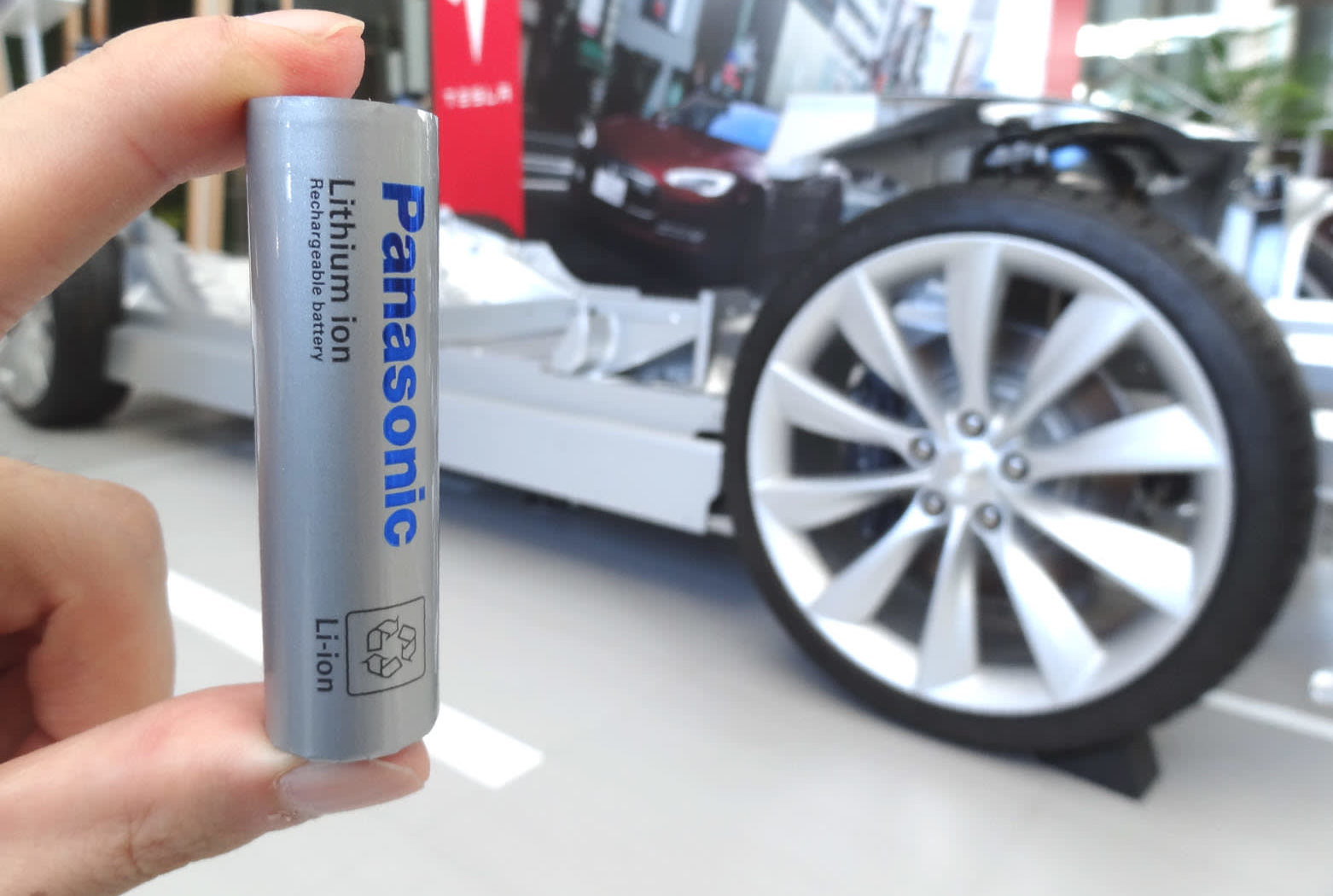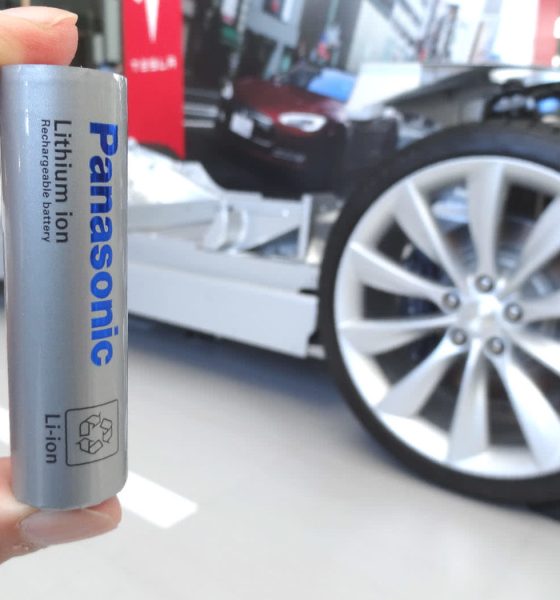

Energy
Panasonic slumps as Tesla branches out with new battery deal
Japanese battery maker Panasonic’s appears to be feeling the direct effects of its partnership with California-based electric car maker Tesla. Just recently, Panasonic opted to cut its profit outlook for 2019 over China’s slowing economy due to the trade war against the United States. Amidst these headwinds, Panasonic’s partnership with Tesla proved to be a silver lining for the Japanese company, pushing its battery business towards profitability — the first time in three quarters.
During a briefing about its adjusted forecasts, Panasonic Chief Financial Officer Hirokazu Umeda pointed out that there have been improvements with sales and profit on its battery business over the past months. Umeda notes that much of these improvements are due to its partnership with Tesla, especially considering the upgrades that Panasonic rolled out to its battery cell lines in Gigafactory 1. Overall, Tesla’s business gave Panasonic an operating profit of 16.5 billion yen (around $150M).
“Sales and profit at the Tesla business have improved,” Umeda said, later adding that additional lines at Gigafactory 1 would be installed by the end of March. The Panasonic CFO noted that with the upcoming improvements, Gigafactory 1’s total capacity could reach 35 GWh.
While its battery business appears to be thriving under its partnership with Tesla, Panasonic’s shares were walloped on Tuesday nonetheless. The Japanese firm’s 6.5% decline on Tuesday transpired amidst news that Tesla is acquiring ultracapacitor firm Maxwell Technologies in an all-stock deal valued at around $218 million. Considering that the opportunities presented by the Maxwell acquisition are related to Tesla’s battery technology, one could almost assume that Panasonic is practically losing its exclusivity as the electric car maker’s sole battery provider.
That said, industry analysts from Japan have noted that Panasonic’s recent decline in the market is primarily due to the company’s bleak quarterly earnings and annual profit estimate, which featured a 9% cut in its operating profit outlook and a decline of 19% for Q4 2018. This was a point highlighted by Masahiko Ishino, an analyst from the Tokai Tokyo Research Center, who noted in a statement to Reuters that Panasonic’s dive in the market was mostly due to the company’s outlook.
“The latest earnings have revealed how tough the situation is for Panasonic,” he said.
In a way, both Tesla and Panasonic appear to be branching out in their respective battery endeavors. Apart from acquiring Maxwell and its ultracapacitor tech, Tesla is also reportedly looking to partner with local battery suppliers in China for vehicles that will be produced at Gigafactory 3. On the other hand, Panasonic appears to be doing the same thing, recently teaming up with Toyota Motor Corp to collaborate in the development and production of rectangular-shaped prismatic batteries. Panasonic is also hoping to supply prismatic batteries to carmakers such as Honda, using the technology it would be developing with Toyota.
While these updates from Tesla and Panasonic might give the impression that the two companies are starting to diverge from each other, such an idea would be inaccurate. The batteries for Tesla’s electric cars and energy storage devices built in the US, after all, are still exclusively supplied by Panasonic. That means that the Japanese company would still be heavily invested in Tesla, as the electric car maker continues the Model 3 ramp and as it raises the production of its energy products like the Powerwall 2. Considering Tesla’s product roadmap, there is a very good chance that the electric car maker’s partnership with Panasonic would last for a long time to come.

Cybertruck
Tesla updates Cybertruck owners about key Powershare feature

Tesla is updating Cybertruck owners on its timeline of a massive feature that has yet to ship: Powershare with Powerwall.
Powershare is a bidirectional charging feature exclusive to Cybertruck, which allows the vehicle’s battery to act as a portable power source for homes, appliances, tools, other EVs, and more. It was announced in late 2023 as part of Tesla’s push into vehicle-to-everything energy sharing, and acting as a giant portable charger is the main advantage, as it can provide backup power during outages.
Cybertruck’s Powershare system supports both vehicle-to-load (V2L) and vehicle-to-home (V2H), making it flexible and well-rounded for a variety of applications.
However, even though the feature was promised with Cybertruck, it has yet to be shipped to vehicles. Tesla communicated with owners through email recently regarding Powershare with Powerwall, which essentially has the pickup act as an extended battery.
Powerwall discharge would be prioritized before tapping into the truck’s larger pack.
However, Tesla is still working on getting the feature out to owners, an email said:
“We’re writing to let you know that the Powershare with Powerwall feature is still in development and is now scheduled for release in mid-2026.
This new release date gives us additional time to design and test this feature, ensuring its ability to communicate and optimize energy sharing between your vehicle and many configurations and generations of Powerwall. We are also using this time to develop additional Powershare features that will help us continue to accelerate the world’s transition to sustainable energy.”
Owners have expressed some real disappointment in Tesla’s continuous delays in releasing the feature, as it was expected to be released by late 2024, but now has been pushed back several times to mid-2026, according to the email.
Foundation Series Cybertruck buyers paid extra, expecting the feature to be rolled out with their vehicle upon pickup.
Cybertruck’s Lead Engineer, Wes Morrill, even commented on the holdup:
As a Cybertruck owner who also has Powerwall, I empathize with the disappointed comments.
To their credit, the team has delivered powershare functionality to Cybertruck customers who otherwise have no backup with development of the powershare gateway. As well as those with solar…
— Wes (@wmorrill3) December 12, 2025
He said that “it turned out to be much harder than anticipated to make powershare work seamlessly with existing Powerwalls through existing wall connectors. Two grid-forming devices need to negotiate who will form and who will follow, depending on the state of charge of each, and they need to do this without a network and through multiple generations of hardware, and test and validate this process through rigorous certifications to ensure grid safety.”
It’s nice to see the transparency, but it is justified for some Cybertruck owners to feel like they’ve been bait-and-switched.
Energy
Tesla starts hiring efforts for Texas Megafactory
Tesla’s Brookshire site is expected to produce 10,000 Megapacks annually, equal to 40 gigawatt hours of energy storage.

Tesla has officially begun hiring for its new $200 million Megafactory in Brookshire, Texas, a manufacturing hub expected to employ 1,500 people by 2028. The facility, which will build Tesla’s grid-scale Megapack batteries, is part of the company’s growing energy storage footprint.
Tesla’s hiring efforts for the Texas Megafactory are hinted at by the job openings currently active on the company’s Careers website.
Tesla’s Texas Megafactory
Tesla’s Brookshire site is expected to produce 10,000 Megapacks annually, equal to 40 gigawatt hours of energy storage, similar to the Lathrop Megafactory in California. Tesla’s Careers website currently lists over 30 job openings for the site, from engineers, welders, and project managers. Each of the openings is listed for Brookshire, Texas.
The company has leased two buildings in Empire West Business Park, with over $194 million in combined property and equipment investment. Tesla’s agreement with Waller County includes a 60% property tax abatement, contingent on meeting employment benchmarks: 375 jobs by 2026, 750 by 2027, and 1,500 by 2028, as noted in a report from the Houston Business Journal. Tesla is required to employ at least 1,500 workers in the facility through the rest of the 10-year abatement period.
Tesla’s clean energy boom
City officials have stated that Tesla’s arrival marks a turning point for the Texas city, as it highlights a shift from logistics to advanced clean energy manufacturing. Ramiro Bautista from Brookshire’s economic development office, highlighted this in a comment to the Journal.
“(Tesla) has great-paying jobs. Not just that, but the advanced manufacturing (and) clean energy is coming to the area,” he said. “So it’s not just your normal logistics manufacturing. This is advanced manufacturing coming to this area, and this brings a different type of job and investment into the local economy.”
Energy
Tesla and Samsung SDI in talks over new US battery storage deal: report
The update was related by industry sources and initially reported by South Korean news outlets.

Recent reports have suggested that Tesla and Samsung SDI are in talks over a potential partnership to supply batteries for large-scale energy storage systems (ESS).
The update was related by industry sources and initially reported by South Korean news outlets.
ESS batteries to be built at Samsung’s Indiana plant
As noted in a report from Korea JoongAng Daily, the demand for energy storage systems has been growing rapidly in North America, thanks in no small part to the surge in AI investments across numerous companies. With this in mind, Tesla has reportedly approached Samsung SDI about a potential battery supply deal.
The deal is reportedly worth over 3 trillion Korean won (approximately $2.11 billion) and will span three years, according to The Korea Global Economic Daily. A battery supply deal with Samsung SDI could make sense for Tesla as the company already has a grid-scale battery, the Megapack, which is perfect for industrial use. Samsung SDI could simply supply cells for the EV maker.
Production of the batteries would reportedly take place at Samsung SDI’s joint venture factory with Stellantis in Indiana, which is currently under construction. Samsung SDI recently announced plans to use part of that plant’s EV lines to produce cells for ESS, with a targeted capacity of 30 GWh by the end of next year.
Tesla and Samsung’s partnership
At present, only a handful of manufacturers, including Korea’s LG Energy Solution, Samsung SDI, SK On, and Japan’s Panasonic, are capable of producing energy storage-scale batteries domestically in the United States. A Samsung SDI official issued a comment about the matter, stating, “Nothing has been finalized regarding cooperation with Tesla.”
The possible energy storage system deal adds another layer to Tesla’s growing collaboration with Samsung, which is already in line as a partner in the upcoming production of Tesla’s AI5 and AI6 chips. Early sample manufacturing of the AI6 is expected to begin in South Korea, with mass production slated for Samsung’s Texas-based Taylor foundry when it starts operations.
The AI6 chip will power Tesla’s next wave of high-volume projects, including the Optimus humanoid robot and the autonomous Cybercab service. Musk has called the partnership with Samsung a “real collaboration,” adding that he personally plans to “walk the line” at the Taylor facility to speed up progress.








